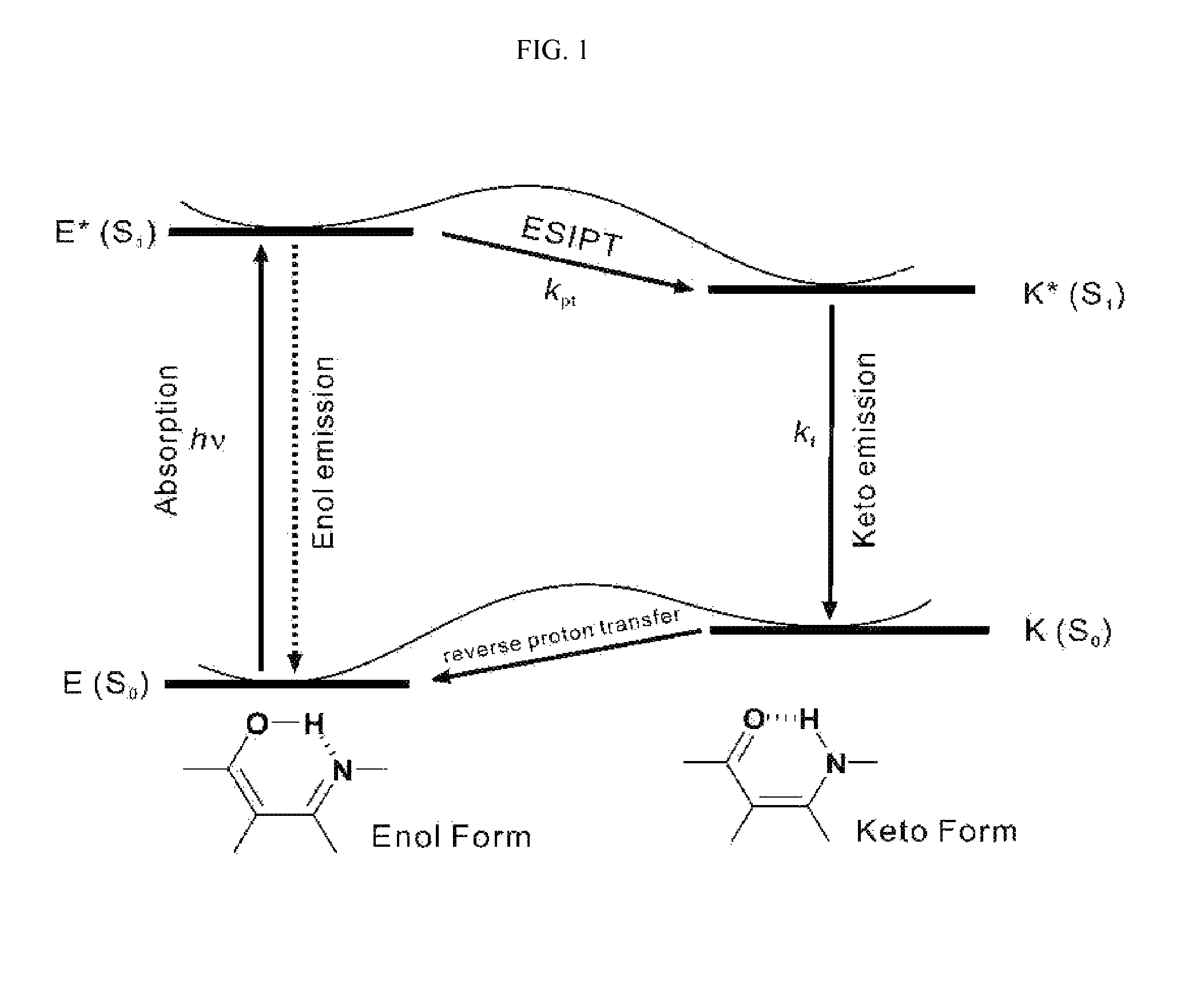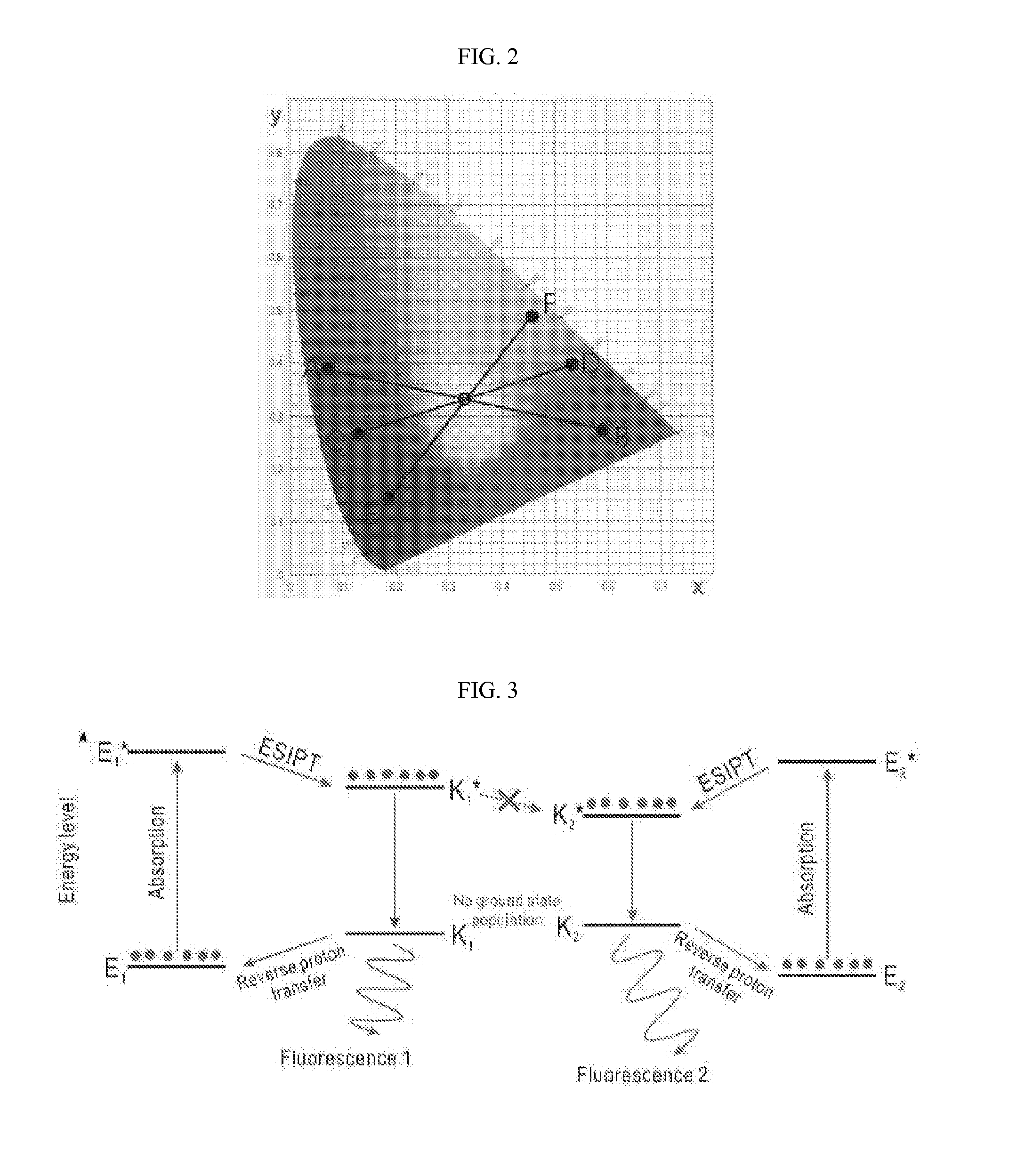White-emitting compounds using excited-state intramolecular proton transfer, organic electroluminescent element and laser material using the same
a technology of excited-state proton transfer and white-emitting compounds, which is applied in the direction of organic chemistry, energy-saving lighting, sustainable buildings, etc., can solve the problems of difficult to achieve color control, difficult to develop white-light-emitting compounds, and significant deterioration of color purity and stability, etc., to achieve enhanced life characteristics, demonstrate stability, and improve reproducibility
- Summary
- Abstract
- Description
- Claims
- Application Information
AI Technical Summary
Benefits of technology
Problems solved by technology
Method used
Image
Examples
synthesis example
[0094]In order to efficiently cover the visible light area ranging from 400 nm to 700 nm, 2-(1,4,5-triphenyl-1H-imidazole-2-yl)phenol (HPI, λmax=460 nm), 2,5-bis(5-(4-tert-butylphenyl)-1,3,4-oxadiazole-2-yl)benzene-1,4-diol (DOX, λmax=580 nm), 3-(1,4,5-triphenyl-1H-imidazole-2-yl)naphthalene-2-ol (HPNI, λmax580 nm) were selected from ESIPT molecules having emission wavelengths of complementary colors for blue and orange, and the white-emitting monomolecular compounds of Formulae 18, 20, 22 and 24, including the selected molecules or combinations thereof, were synthesized.
synthesis example 1
3-(4-nitrophenoxy)benzoic acid
[0095]7.52 ml of fluoro-4-nitrobenzene (70.8 mmol) and 9.79 g of 3-hydroxybenzoic acid (70.8 mmol) were dissolved in 150 ml of DMSO at room temperature, 21 g of potassium carbonate (151.9 mmol) was added thereto, heated to 130° C. and then reacted for 12 hours. The reactant solution was poured into excess water, neutralized with hydrochloric acid, filtered, and dried to yield a product having Formula 25 as a white powder (18.7 g, Yield 98%). 1H NMR (300 MHz, CDCl3) analytical results of the product were as follows:
[0096]1H NMR (300 MHz, CDCl3): □ [ppm] 7.03 (d, 2H), 7.33 (d, 1H), 7.54 (t, 1H), 7.80 (s, 1H), 7.98 (d, 1H), 8.22 (d, 2H), 12.70 (s, 1H)
[0097]
synthesis example 2
ethyl3-(4-nitrophenoxy)benzoate
[0098]18 g of 3-(4-nitrophenoxy)benzoic acid (69.4 mmol) prepared in Synthesis Example 1 was dissolved in 120 ml of ethanol, 35 ml of hydrochloric acid (10N) was added thereto, heated to 110° C. and then reacted for 12 hours. The reactant solution was poured into excess water, neutralized with a 1N aqueous solution of sodium chloride, filtered, and dried with magnesium sulfate, followed by removing ethylacetate, to yield a tacky product having Formula 26 (19 g (˜65 mmol), Yield 95%). 1H NMR (300 MHz, CDCl3) analytical results of the product were as follows:
[0099]1H NMR (300 MHz, CDCl3): □ [ppm] 1.28 (s, 3H), 4.30 (t, 2H), 7.20 (d, 2H), 7.35 (d, 1H), 7.73 (s, 1H), 7.82 (t, 1H), 7.78 (d, 1H), 8.22 (d, 2H).
[0100]
PUM
| Property | Measurement | Unit |
|---|---|---|
| temperature | aaaaa | aaaaa |
| temperature | aaaaa | aaaaa |
| temperature | aaaaa | aaaaa |
Abstract
Description
Claims
Application Information
 Login to View More
Login to View More - R&D
- Intellectual Property
- Life Sciences
- Materials
- Tech Scout
- Unparalleled Data Quality
- Higher Quality Content
- 60% Fewer Hallucinations
Browse by: Latest US Patents, China's latest patents, Technical Efficacy Thesaurus, Application Domain, Technology Topic, Popular Technical Reports.
© 2025 PatSnap. All rights reserved.Legal|Privacy policy|Modern Slavery Act Transparency Statement|Sitemap|About US| Contact US: help@patsnap.com



